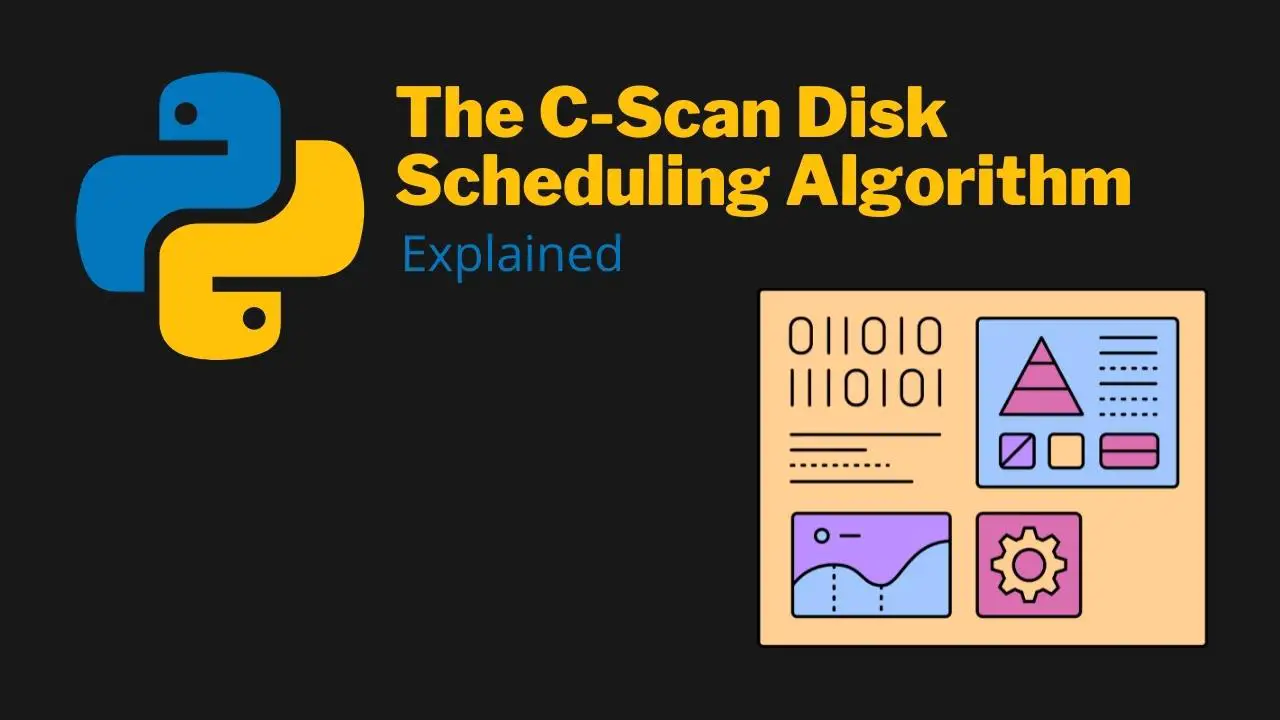The C-Scan disk scheduling algorithm is a disk scheduling algorithm that is designed to ensure that all jobs get the minimum amount of processor time. It achieves this by ensuring that each job is allocated enough time to complete its execution, known as the completion time. The idea behind this algorithm is to scan through the list of pending assignments and assign them slots on the CPU based on their priority and whether they have been waiting long enough for their fair share of CPU time. In this article, we will learn how to use Python 3 to implement a C-scan scheduling strategy in the C language based on this technique without any third-party libraries or external dependencies.

Table of Contents
- What is the C-Scan algorithm?
- Where Is the C-Scan Algorithm Used?
- Ways to Use the C-Scan Algorithm With Python 3
- Wrapping Up
What is the C-Scan algorithm?
C-Scan is an algorithm that can detect the presence of a signal in a time domain. The C-Scan algorithm is designed to identify the movement within the time domain. The algorithm compares the input signal with a reference signal and measures the difference between them.
The basic idea behind this algorithm is that if you have two signals, one with a known frequency and amplitude and another unknown, you can find out what its frequency and amplitude are by subtracting the known from the novel. For example, if you want to find out how fast your car is traveling, all you need to do is measure how long it takes for your vehicle to travel halfway across your driveway and then add that time to how long it took you to drive at half speed.
The C-Scan algorithm calculates how much time it takes for an unknown signal’s envelope to decay after being fed into an oscilloscope or spectrum analyzer. Suppose we have a strange impulse train with a duration of T seconds at frequency f Hz; then, if we provide this impulse train into an oscilloscope or spectrum analyzer with bandwidth B Hz. C-Scan is a popular algorithm in the field of image processing. It enhances the quality of pictures by removing noise, blur, and other defects. The algorithms are used to enhance images’ color, sharpness, and contrast to achieve a better picture quality. Below are some advantages of C-Scan.
High Speed
The C-Scan algorithm is capable of scanning a large number of samples in a short period, which makes it ideal for applications such as crystallography and microscopy. This is because the machine can read out data from individual crystal planes or even individual pixels on the screen of a microscope camera at a rate many times faster than other methods.
High Accuracy
The C-Scan algorithm is accurate and robust in detecting the presence or absence of molecules in samples with low concentrations (less than 1%). Some researchers have even used it to detect single molecules at room temperature!
Flexibility
C-Scan also has flexibility built into it, so users can adjust its parameters to suit their needs by increasing or decreasing the resolution of the data they receive from their instrument. This means C-Scan can be used on any device that reads out X-ray diffraction patterns from crystals or other types of specimen; all you need to do is specify what kind of pattern you want your machine to look for (crystal or liquid), how much information you want about each diffraction peak.
Scalability
The C-Scan algorithm is scalable to any number of scans in a single pass. This means that the system can scan large numbers of items in a short time without any loss of quality or speed.
Where Is the C-Scan Algorithm Used?
The c-Scan algorithm is the essential tool for a forensic computer examiner to uncover the user’s true identity. C-Scan is software that analyzes the contents of hard drives and other storage devices. It can be used in court as evidence or for forensic purposes. The C-Scan software runs its first scans on a Windows system as part of a standard installation process. The second scan occurs after Windows has been installed and then again after an update has been applied.
C-Scan is a powerful tool that can help you analyze real-time data. It is widely used in many retail, finance, and marketing industries. The c-Scan algorithm is used in almost all the countries of the world. The main reason is that it is a highly reliable tool for detecting counterfeit money. The C-Scan algorithm has often been used to see fake notes and other items. Some of these occasions are:
Counterfeit Currency Detection

Counterfeit currency detection is one of the most important uses of the C-Scan algorithm. It helps detect fake notes and other items such as passports, visas, etc. In this case, the machine scans an entire stack of currency with a high-speed camera that captures each paper note’s images before bringing them into a computer system, which is processed by a special algorithm that detects anomalies in the scanned images. This process enables the computer to identify any changes or inaccuracies present in each note that may indicate its authenticity or otherwise.
Identity Authentication

Sometimes we must prove our identity when we need to access certain services like banks or government offices. For example, if someone needs to open a bank account, they must provide proof of identity like a passport or driver’s license, etc.
Finance

Financial institutions widely use c-Scan to identify fraudulent transactions and detect account fraud. The algorithm helps banks to see fraudulent transactions that are made through online banking or mobile banking.
Ways to Use the C-Scan Algorithm With Python 3
If you’re new to machine learning, knowing where to start cannot be easy. Below are three ways you can use the C-Scan algorithm with Python 3.
Use the C-Scan Algorithm as a Library
The C-Scan algorithm is easy enough to use directly in your program. It’s also very flexible, so you can easily add it to other machine learning techniques.
Create a Simple Model
The C-Scan algorithm is simple enough that you don’t need much more than a few lines of code to create a model from it. It’s also easy enough that even programmers without any machine learning experience can make something useful with it.
Create a More Complex Model
You can take your model further by adding more layers and modifying the weights based on what your data tells you about what works best for predicting which items people think are similar or different from each other (see our post on deep learning for this purpose).
Wrapping Up
The C-Scan Disk Scheduling Algorithm is used to solve the problem of scheduling disk usage to prevent fragmentation and decrease wait times for processes, as heavily fragmented disks increase response time for all methods. The c-scan algorithm modifies the first come, first serve (FCFS) algorithm but utilizes knowledge about disks that FCFS lacks. By dividing the time interval into “watches,” it can know what parts of the disk are heavily fragmented. This allows it to move a process from one “watch” to another when it would be helpful instead of waiting until the process’s next scheduled execution point.
🐍 Learn Python Programming
🔨 Python Basics
👉 Python Syntax
👉 Python Variables
👉 Python print()
👉 Python input()
👉 Python Constants
👉 Python Comments
⚙️ Python Specifics
👉 Filter Lists in Python
👉 Replacing List Items in Python
👉 Create a GUI in Python
👉 Find out the Length of a String in Python
👉 Enum in Python
👉 Python Inline If/Else One-Line Statements
👉 Python xrange()
👉 Python List Slicing
🏋️ Python Exercises
👉 Python Exercise Collection

